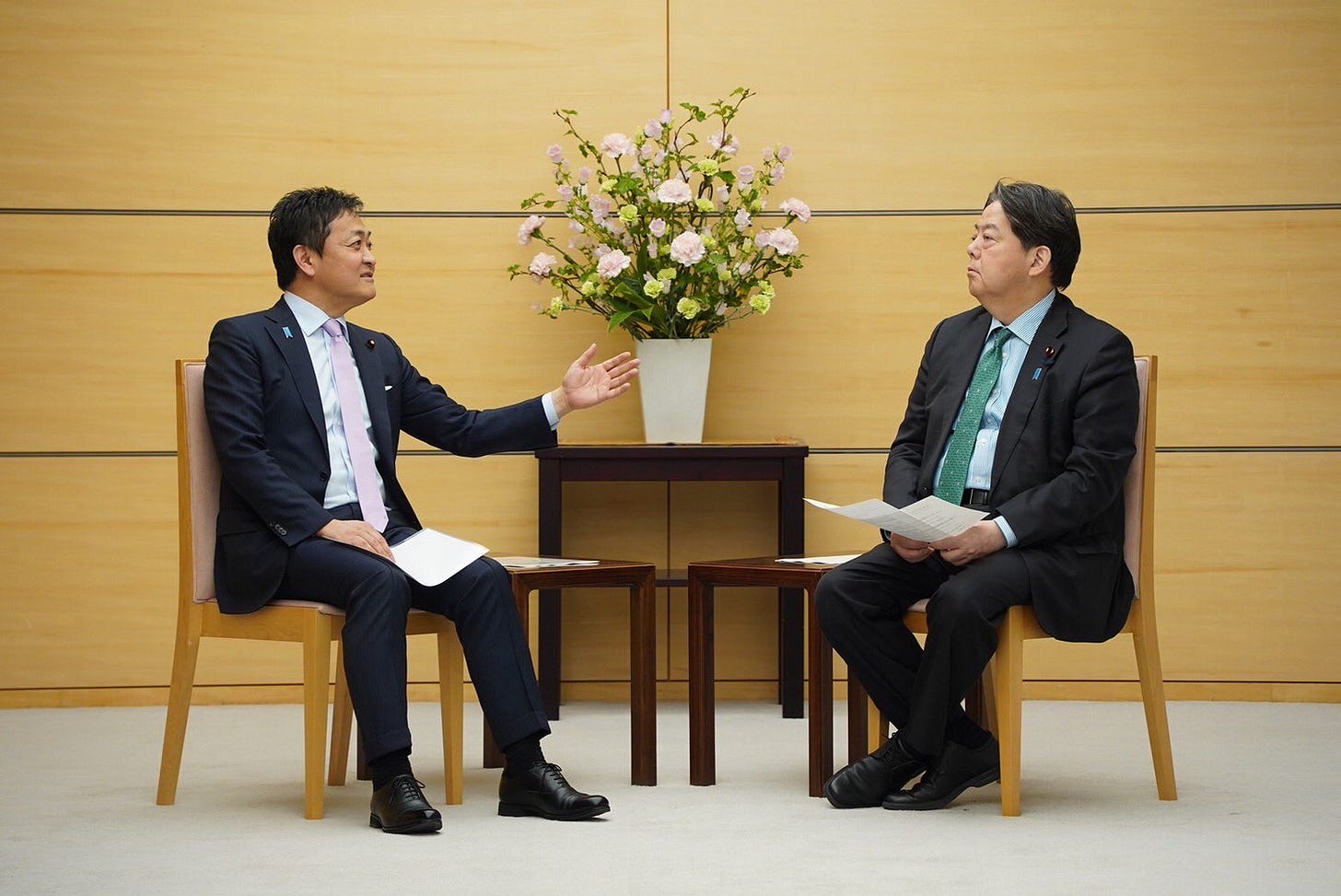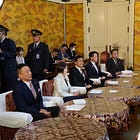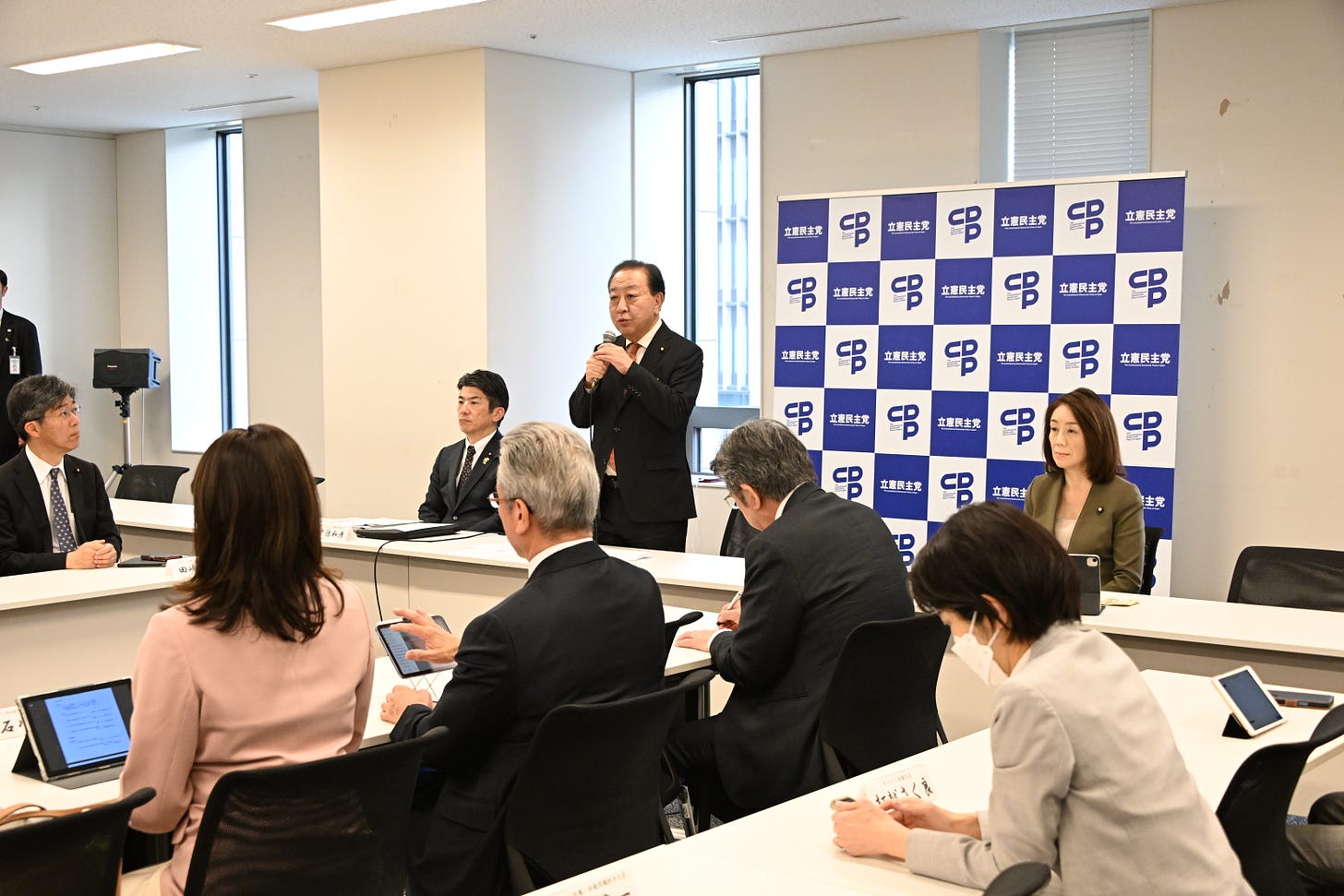Ishiba's balancing act
His government's approach to the Trump Shock is taking shape -- but it is easy to see how it could go wrong
Thank you for reading Observing Japan. This post is available to all readers.
If you are looking for timely, forward-looking analysis of the stories in Japans’s politics and policymaking that move markets, I have launched a new service through my business, Japan Foresight LLC. For more information about Japan Foresight’s services or for information on how to sign up for a trial or schedule a briefing, please visit our website or reach out to me.
I will be holding another monthly conference call for paid subscribers on Wednesday, 16 April at 9am EDT/10pm JST. Details available here. Subscribe below to be able to join the call.

While the Ishiba government was not disappointed in Donald Trump’s decision to suspend “reciprocal” 24% tariffs for ninety days, the government remains on a crisis footing as Japan still faces US tariffs of 25% on its automobile, steel, and aluminum exports and 10% on everything else, has to navigate the impact of triple-digit US tariffs on China, and the prospect that Trump could still move ahead with the 24% tariffs at the end of the ninety-day reprieve. The government also, of course, must manage turbulence in financial markets that has, for the moment, strengthened the yen and reduced long-term Japanese government bond yields as Japan appears to be serving as a safe haven for investors.
Prime Minister Ishiba Shigeru has pursued a multi-track response to the crisis. First, his government is making a serious effort to engage with the Trump administration to negotiate a way out of the trade dispute. To this end, Ishiba named Akazawa Ryōsei, the minister of economic revitalization and one of his closest allies – like Ishiba, Akazawa is from Tottori prefecture – as his chief trade negotiator. Akazawa will leave for Washington on 16 April for talks with US Treasury Secretary Scott Bessent and US Trade Representative Jamieson Greer, his counterparts in the negotiations.
Ishiba has shown a tendency to rely on a small circle of allies in his personnel decisions, so it should perhaps not be surprising that Ishiba looked to Akazawa for what could be the single-most important personnel decision he will have to make. However, Akazawa’s resume is thinner than some of Japan’s previous trade negotiators – Akazawa is in his first ministerial post, compared with Amari Akira and Motegi Toshimitsu, who negotiated trade agreements under Abe Shinzō – and he has been questioned for his lack of international negotiating experience. Some, particularly Constitutional Democratic Party (CDP) leader Noda Yoshihiko, have suggested that Ishiba bring back Motegi to be his negotiator, in light of Trump’s praise for Motegi as a “tough negotiator.”

Akazawa will not only have to contend with questions about his abilities – the Asahi Shimbun reported that when informed that Akazawa would be negotiating on behalf of the Japanese government, an anonymous US government source said, “Akazawa who?” – he may also find that his authority is constrained. Asahi quoted an Ishiba government source as saying that Chief Cabinet Secretary Hayashi Yoshimasa, who by contrast has extensive international experience, will be managing the negotiations behind the scenes. Meanwhile, Finance Minister Katō Katsunobu, who has already talked with Bessent about exchange rate issues, has said that he will be responsible for any discussion of exchange rates as part of the negotiations, and will likely have his own talks with Bessent, perhaps during the International Monetary Fund-World Bank spring meetings in Washington the week of 21 April. Akazawa will also have to reckon with divisions within Kasumigaseki over the tariffs, as ministries battle over what concessions to offer on tariffs (particularly on agriculture) and non-tariff barriers, a battle that could be waged within the thirty-seven-member task force under Hayashi’s and Akazawa’s lead drawn from across the bureaucracy and among the separate task forces stood up by the ministries themselves.
Of course, Akazawa will also have to grapple with the Trump administration itself, which has given little clarity on what it intends to achieve in the reciprocal trade talks. The talks could become contentious quickly if, for example, the US presses for concessions from Japan on agricultural market access – US Trade Representative Greer told Congress this week “We feel like we should have more and better agricultural market access” – which may be difficult for Ishiba to deliver on short notice, with farmers already agitated over worsening conditions and upper house elections approaching in July.
While the Ishiba government prepares for negotiations with the United States, it is also deep into negotiations with both the ruling parties and the opposition parties over how to limit the impact of the Trump Shock on Japan’s economy. To a certain extent, Ishiba won an important victory this week when the Constitutional Democratic Party (CDP) said it would, in light of the national crisis, back off from pressing Ishiba for accountability on the gift-giving scandal and would take a constructive attitude towards drafting a stimulus package to deliver relief to businesses and households. As part of this truce, the LDP and CDP agreed to hold meetings of the lower house and upper house budget committees on 14 and 21 April respectively to discuss the US tariffs and the Ishiba government’s response.

That said, there will be little easy about introducing fiscal stimulus. The government itself has not formally committed to a supplemental budget – not least because a supplemental budget means negotiating with the opposition parties for the votes to pass a budget in the House of Representatives – though it is widely assumed that it will have little choice. Every party is certainly positioning itself as if it is inevitable, offering their proposals to the government for how to deliver relief as effectively as possible. But the desire to manage the impact of the Trump Shock is running headlong into Ishiba's desire to put Japan on a more sustainable fiscal trajectory, ironically so that Japan is better able to respond to disasters and crises.
The main point of contention has become whether to include a consumption tax cut – whether across the board or just on food purchases – as part of a stimulus package. The Democratic Party for the People (DPFP) has proposed cutting it from 10% to 5%. The CDP, led by the fiscally conservative Noda Yoshihiko, has been more circumspect, with some members calling for zeroing out the 8% tax on foodstuffs, though others are resistant. (Edano Yukio has called the eagerness to slash taxes “irresponsible populism.”) The ruling coalition itself is divided, not least because of fears that the ruling parties face a tough upper house campaign. Kōmeitō has suggested a tax cut on foodstuffs – which are already taxed at a lower rate due to a Kōmeitō initiative – should be part of the discussion. Within the LDP, upper house members naturally are leading the charge for fiscal stimulus and are the most receptive to including some kind of consumption tax cut in the package. The baseline position in the party is that the government needs to provide direct cash payments to households on the order of JPY 30,000-50,000, but the demands for more – particularly from the fiscally dovish right wing – could grow louder.1
The official response from the Ishiba government has been resistance to cutting the consumption tax, for fear that it will create a significant hole in the budget that will have to be covered by new debt and that once cut it will be difficult to raise it again when the crisis has passed; both would put the government’s goal of fiscal sustainability further out of reach. At any rate, the government has not formally committed to a supplemental budget, relying for the moment on lending via public financial institutions to relieve tariff-hit businesses while it negotiates with the United States and gathers more information on the impact on Japan’s economy. But there is a risk that if the government waits too long it could find itself having to scramble to pass a supplemental budget before the Diet session is scheduled to end on 22 June – with little room to extend the session due to the upper house election – giving the opposition more leverage in the debate.
Finally, the Ishiba government’s response has a third pillar that is, to this point, the most underdeveloped, namely mounting a defense of a rules-based free trade system in cooperation with other major economies. To be sure, Tokyo is prioritizing negotiations with the Trump administration over talks with other trading partners; the Ishiba government has not done anything as dramatic as the European Union and China attempting to revive their stalled negotiations. But the government is quietly reaching out to other G7 members – Ishiba spoke with British Prime Minister Keir Starmer on 10 April and Katō with his Canadian counterpart François-Philippe Champagne on 9 April – and Ishiba has been increasingly emphasizing the need to defend the World Trade Organization. Of course, even before the reciprocal tariffs were announced, the Japanese, Chinese, and South Korean governments had already agreed to accelerate their ongoing negotiations for a trilateral free trade agreement and to support “the rules-based, open, inclusive, transparent, non-discriminatory multilateral trading system with the WTO at its core.” During the first Trump administration, Japan eventually revived the Trans-Pacific Partnership; concluded an economic partnership agreement with the EU; and helped bring the Regional Comprehensive Economic Partnership (RCEP) agreement to completion. Ishiba may have less low-hanging fruit for deepening economic integration, but his government is still likely to pursue opportunities to protect these achievements. As Nikkei columnist Akita Hiroyuki proposes, it may be time for a G6+ arrangement bringing together Japan, leading European countries, the EU, Australia, New Zealand, South Korea, and other leading democracies.
Ultimately, Ishiba is running a complicated balancing act. He is seeking “win-win” negotiations with the Trump administration without angering his party’s supporters with unpopular concessions or caving to pressure; he is trying to insulate Japan’s economy from US tariffs without pursuing deficit-busting stimulus; and he is trying to preserve Japan’s partnership with the United States while also defending a rules-based trading system. And, of course, he is also trying to do this with his public support weak and the opposition – while temporarily willing to cooperate in the name of national unity at a time of crisis – prepared to press him hard if he cannot manage this balancing act.2
Japan may have received a ninety-day reprieve from Trump, but Ishiba has not. It could take very little – extreme demands from the US in negotiations, strong pressure from the opposition or his own backbenches on the fiscal stimulus, overt opposition from LDP kingmakers, or a no-confidence motion from the opposition – for the Trump Shock to make Ishiba’s – and the LDP’s – situation untenable, resulting in, as Asō Tarō warned Friday, “a Japan that cannot decide anything.”
Portentously, although his party colleague Edano said the party should forego a no-confidence vote so as not to cause a leadership crisis, Noda said while he would not want to submit a no-confidence motion for purely political reasons, he would not rule one out if it appeared that Ishiba was not up to managing negotiations with the US.






